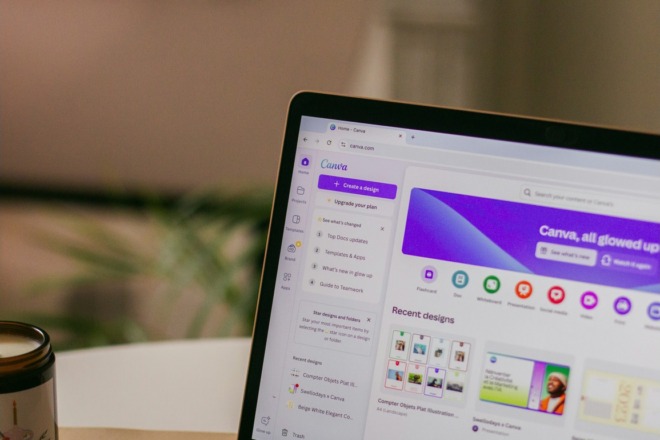Have you ever walked down a busy street, and something catches your eye? It may have been a familiar image or logo, and you knew which company it represents exactly.
It can be incredible how a simple design can speak volumes. That’s the power of a logo — it’s much more than something pretty to look at.
Your brand’s image is the face people see when they encounter your business. Top performing corporations spend thousands on a new logo. It’s such a crucial part of awareness that organizations are reluctant to change it. How can you create a logo when you’re on a shoestring budget and still get noticed?
In the northeastern United States, there are 74,326 small businesses all vying for competition. Multiply that by the other areas of America as well as the global small business landscape. When you realize just how much noise there is in offline and online advertising, the need for a consistent brand image increases.
So, how can you create a logo from scratch without spending a fortune? How can you ensure the image competes with bigger players in your industry? Follow these tips.
1. Know the Basics of Logo Design
A good logo should make a positive first impression on customers. When creating a logo, you should ensure it incorporates several crucial elements:
- Simple
- Memorable
- Adaptable
- Timeless
When creating a new design, it can be easy to think it needs to be complex. However, the best logos ensure they’re easily recognizable by including only a few elements. Yet, a simple logo can have unique features so that it sticks into people’s minds.
Think of Nike’s emblem. The iconic swoosh represents the wing of the Greek goddess of victory. While the sportswear company maintains simplicity in its logo’s design, it still has a unique aspect that people have recognized and remembered over the years.
Additionally, your design should be adaptable so it can be of use in different contexts. For instance, the image should be able to fit on a business card or billboard without losing its impact.
Lastly, a good logo design should be timeless. This means that it should remain effective and relevant even as trends change. Using a logo with funky typography could become outdated in the near future.
2. Study the Competition
As with almost anything you do, knowing your niche helps you see how you can stand out from the crowd. What type of logos do other brands in your industry use? Are they word marks? Perhaps they are images.
If you run a preschool, the colors and shapes are going to take center stage. On the other hand, a marketing firm may rely more on an established name and pull that into their logo.
Make a list of the things you like and dislike about other logos. When you create a logo, you’ll want to make sure it is unique from all the others out there, so take the time and do the research.
3. Choose a Logo Type
There are several types of logos, each with its own strengths:
- Wordmarks or logotypes: Made entirely of text and are great for brand name recognition.
- Pictorial marks: These are symbolic, graphic icons that represent a real-world object. These logos work well once you have a well-established brand.
- Abstract: Uses geometric forms to represent your business and evoke the right message and emotion. These are ideal for conveying what your brand does at a glance.
- Combination marks: Blends text and image, making them suitable for various contexts.
- Emblems: Encases the brand name within the design, perfect for creating a classic, sturdy image.
The right type depends on your brand, goals and identity, so choose wisely.
4. Select the Right Color
There is an entire psychology to colors. People feel excitement when they see the color red. Both men and women like the color blue. The hues you choose can help define your brand. Many restaurants and food products use red because some studies show it elicits hunger.
Color makes an impression on people. Around 75% of purchase decisions are based on the shades in a product’s packaging.
Select your color based on your brand’s color palette but also what will pop against other items of a similar nature. For example, if you sell widgets and all the other companies have yellow and blue packaging, add a pop or red or neon pink to grab attention.
Your logo needs to look good against different background colors and at different sizes. Think through the color combinations and what grabs attention. A red background with yellow text may be challenging to red from a distance. Make the red slightly darker and use white text, and it suddenly pops.
5. Tell Your Story
The most memorable brands tell a story. Think about why you started your company and the message you want to send. One example of a logo that defines a brand is FedEx. The letters almost seem to move in the logo, which makes sense since they say they can get a package anywhere fast.
You’ve likely noticed a lot of realtor logos feature keys or houses. What if yours was different from all the rest but still defined warmth and family?
Brainstorm until you come up with the perfect combination of images and words. Finally, cross-check everything to ensure you aren’t repeating what another brand has already done.
6. Create a Logo
Once you have a few ideas in place, it’s time to take your thoughts to some simple graphic design sites and see what you can come up with. Here are a few you can use that allow you to create a logo for free.
- Canva: Their free version allows you to play around with editing a logo. You’ll even have a few templates from which to choose. Of course, the Pro version gives you access to all their elements, images and more features, but you can certainly start with the no-cost version.
- GIMP: If you’re familiar with Photoshop but don’t want to pay the monthly costs of Adobe Suite, you can grab GIMP for free. The open source software has a lot to offer and plenty of online tutorials on how to use it.
- Vistaprint: Sometimes overlooked as a logo generator, Vistaprint helps you come up with a simple, professional look for your brand. You will need to navigate to their logo generator page, and they’ll want you to buy items from them, but their costs are fairly low.
- Logo.com: Here is another free logo generator. You’ll gain the advantage of a huge library of images but might find the results a bit cookie cutter. If you’re looking for a unique logo, you’ll have to do some extra work to get there with this site, but it’s a great place to start for your logo ideas.
There are hundreds of logo generators online. Find the one that is easy for you to use. If you’re struggling to use even the easier ones, it might be time to hire a graphic designer to do the work for you. There are plenty of reasonably priced freelancers available.
7. Where to Find Images
Should you choose to add images to your logo, finding the right ones can seem daunting. How detailed do you want to go? Will it translate well everywhere you use the logo? Can you perhaps add detail in some places, such as digital ads but use an outline elsewhere such as on a business card? Will your logo still be recognizable?
Once you choose the type of image and what it will be, start your hunt for a logo you can use commercially. Sites such as Pixabay offer a repository of images. Make sure you always click on the licensing options and either purchase the image for commercial use or ensure it is able to be used freely and without attribution.
Sites such as Canva and Logo.com come with images you can use and change at will. You may even find using an artificial intelligence art generator such as Dall-E might be worth your while, especially in the initial stages of creating a logo.
8. Choose the Best Font
The text on your logo must be readable. If you use a fancy script, it could be lost as the logo is sized down. Try to stick with fonts that are easy to read at all sizes and device types. You can choose from:
- Serif
- Sans serif
- Script
- Decorative
We recommend avoiding highly flowy fonts with a lot of embellishments for your logo. Save those for poster headings or larger ads. You’ll find there are thousands of fonts from which to choose even when you stick to something basic.
With any design tool you choose, it will come with some preloaded fonts. You can search for other free fonts and upload them to customize your look a bit more.
9. Save Your Logo
Once you’ve created your logo, you need to save it. You should save it in multiple formats for different uses. For example, for social media, you probably only need a basic JPG. On a website, you might want a logo with a transparent background so it allows the website layers to shine through. You would need a PNG with transparency to achieve the look.
Save your logo in different resolutions. You can get by with fewer pixels for digital and need a higher resolution for print materials.
Create a Logo From Scratch in One Day
It shouldn’t take weeks to come up with a logo. You can brainstorm and create one in a day and get your business up and running. Create a logo that defines your brand. Remember that it should have the power to connect with people and share an unforgettable story.
The faster you get your image out into the world, the more quickly you’ll begin attracting your target audience. Find the look that tells your business’ story and then share it everywhere you can think of.
About The Author
Eleanor Hecks is the Editor-in-Chief of Designerly Magazine, an online publication dedicated to providing in-depth content from the design and marketing industries. When she's not designing or writing code, you can find her exploring the outdoors with her husband and dog in their RV, burning calories at a local Zumba class, or curled up with a good book with her cats Gem and Cali.
You can find more of Eleanor's work at www.eleanorhecks.com.


